
_______________________
_______________________
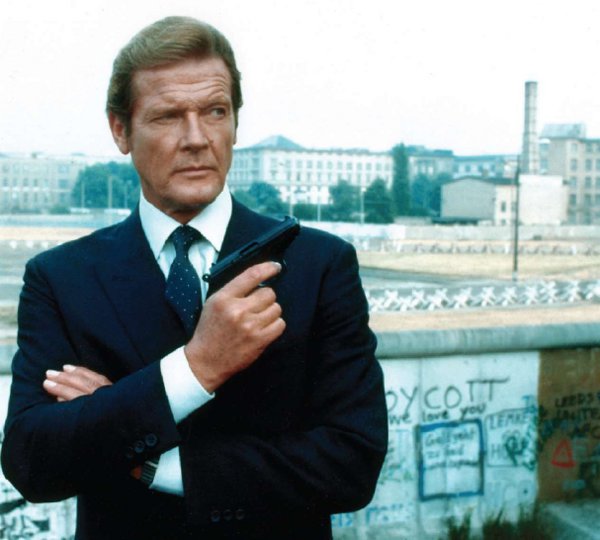
At the Berlin Wall in 1983 at the height of the Cold War.
BOND ON LOCATION
It might actually be easier to say where Bond hasn’t been in the world, though looking at the films, I have so far spotted him travelling to Jamaica, Croatia, Serbia, the UK, the USA, Turkey, Italy, Switzerland, France, Germany, Mexico, Japan, Portugal, Egypt, Lebanon, the Caribbean, Hong Kong, China, Austria, Brazil, Greece, Spain, Russia, Gibraltar, Morocco, Pakistan, Azerbaijan, Monaco, Cuba, South Korea, North Korea, Uganda, Montenegro, Haiti, Bolivia and Madagascar.
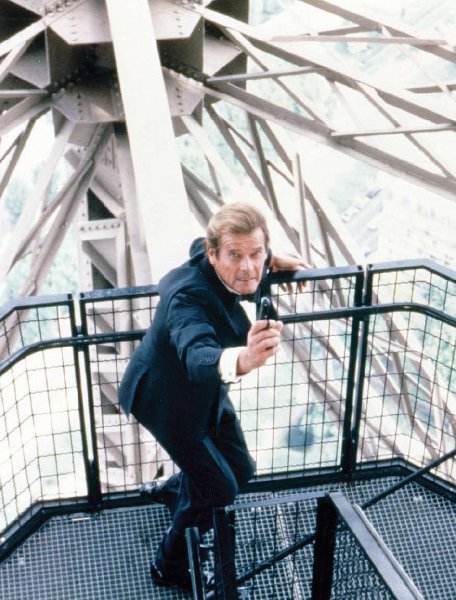
Me being brave on the Eiffel Tower. It’s a long walk up there, you know, with 347 steps to the first level alone.
HOME OR AWAY?
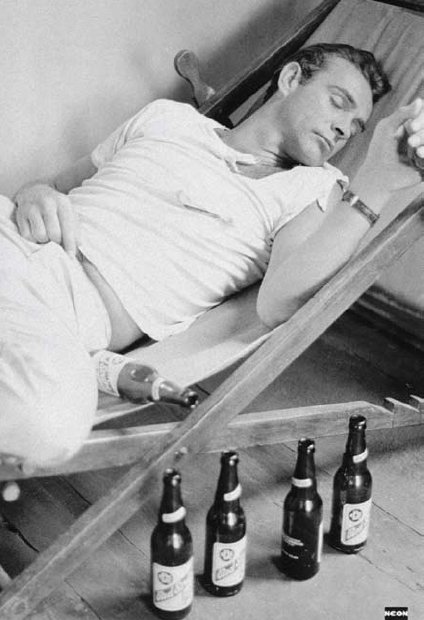
On location in Jamaica, Sean thought it was time for a beer and a nap. He obviously couldn’t get to sleep, and sent for more beer.
Of course, the filmmakers didn’t actually, or necessarily, visit every country – local locations were often dressed to look like somewhere else. For example, RAF Northolt, the Royal Air Force base near Pinewood Studios, doubled as a Cuban airbase in Octopussy, for Blue Grass Kentucky in Goldfinger and as an Azerbaijani airbase in The World Is Not Enough. The opening scenes of Casino Royale were filmed in the same place Sean Connery drove his Aston Martin DB5 in Goldfinger – Black Park, near Slough. Then there was Brent Cross shopping centre doubling for a Hamburg hotel car park in Tomorrow Never Dies; the Nene Valley Railway in Peterborough doubled for East Germany in Octopussy and again in GoldenEye for Russia. Amberley Working Museum in West Sussex doubled for Silicon Valley; and the IBM Building in Staines doubled for the German HQ of Elliot Carver in Tomorrow Never Dies.
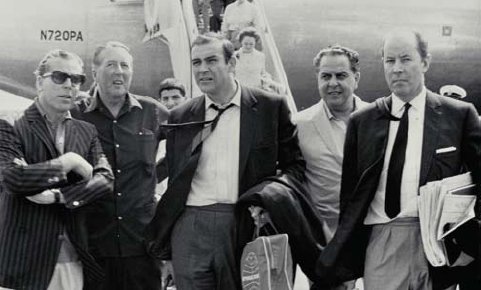
The height of Bondmania was marked with Thunderball. Here Sean arrives for filming in the Bahamas (where he now resides) with Cubby, Terence Young and Kevin McClory.
Typically, when planning 007’s travels, a script outline comes together first, then the writer, director and producers explore potential locations in which to set the action, and from there thrash out the story some more. Many stops along the way turn out to be false trails, with nothing visually exciting to offer; others are too difficult to reach, or don’t have any local infrastructure; and some are politically dodgy, so they’re all ruled out. But once a likely location is confirmed, the whole team of production managers, location managers, production designer and director of photography ship out to lend their thoughts and ideas.
Then there is the important question, ‘Where can we find a top-class hotel for our beloved star, whom we want to treat royally?’
In the 1960s, there were no such things as economy airlines, cheap all-inclusive package holidays – or even colour television in many homes. The only way people were able to see exotic locations and fancy hotels was by buying a ticket to see a Bond film at the cinema. Nowadays it’s harder to find somewhere with which viewers aren’t familiar, which is why places like Azerbaijan and Bolivia pop up on the list.
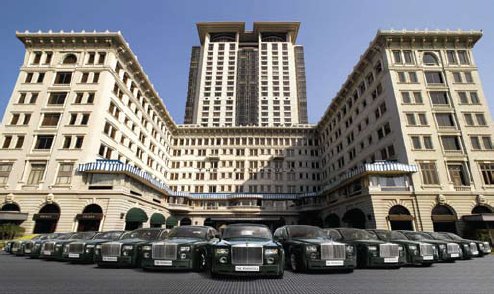
The Peninsula Hotel, Hong Kong, with its trademark green Rolls-Royce cars. Surrounded by press when we filmed there, Britt Ekland smiled at me and said, ‘Oh I do like being a film star.’
Moving around between countries with a 200+ crew is like a military exercise. Typically, in my day, we started off on location, with the unit going ahead by charter and us swanky stars – who secured a first-class flight from the kindly producers – going in a day or two later. Then, with those location scenes in the can, it was back to the studio for a few weeks before jetting off to location number two, thereby allowing the studio stages to be re-dressed with new sets to await our second coming. One therefore had to be prepared to live out of a suitcase for four or five months. Thankfully, I have a big suitcase.
DOUBLING UP
I can’t really go into any great detail on the locations used in the films outside of my seven, as I wasn’t there. So let me tell you about me and mine …
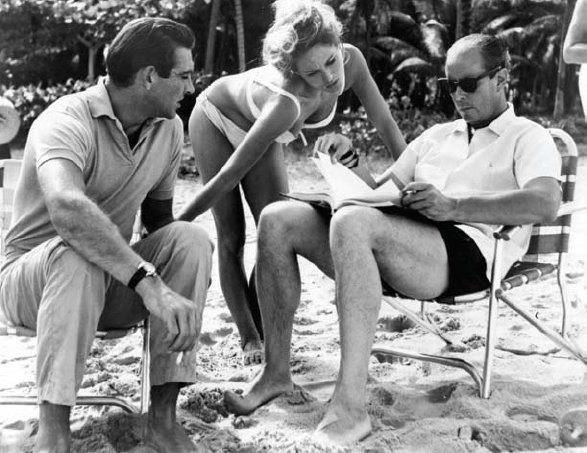
Sean, Terence Young and Ursula Andress on location in Jamaica for Dr. No.
When Live And Let Die was in the planning stage, writer Tom Mankiewicz suggested to Guy Hamilton that they might go to New Orleans. Why? Well, because Guy liked jazz and old Jimbo hadn’t been there before. It sounded like a good enough reason for a trip out there at least – not only was there jazz in New Orleans, there were bayous too.
‘Wouldn’t that give us a great opportunity for a boat chase?’
‘Hey and there’s this crocodile farm upriver …’
‘How about putting Bond in there on an island surrounded by crocs?’
‘Look, there’s this low bridge here. How about we put Bond in a vehicle, and have the villain chase him here?’
‘Yes! How about a double-decker bus?’
… And that’s how scripts and set pieces evolve on a Bond film, and in particular this one.
Locations featured include New Orleans, New York, Jamaica (which, of course, was also the setting for Dr. No) and Louisiana.
One hotel we used in Jamaica was the Couples Sans Souci, in Ocho Rios. It doubled as Bond’s San Monique base, and had, incidentally, been used as Miss Taro’s home in Dr. No a decade earlier. Meanwhile, over at the Half Moon Bay Club in Montego Bay, bungalow 9 was used as Bond’s own. The club also featured in Casino Royale with Daniel Craig, though it had been extensively remodelled by then – and hopefully without any unwelcome snakes slipping in.
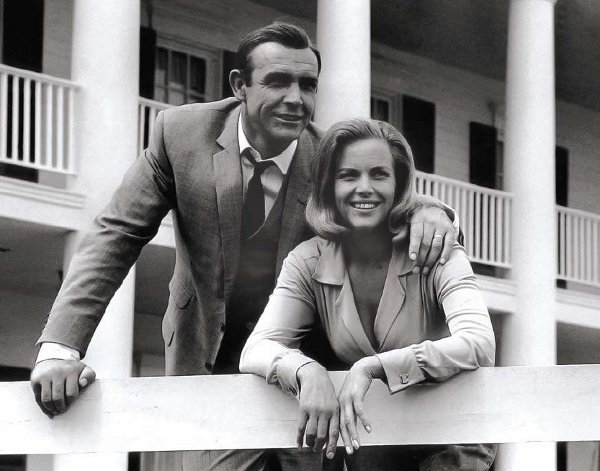
The majority of Goldfinger was set in the USA, including this sequence featuring Honor Blackman and Sean Connery at the villain’s Kentucky ranch – though it was all filmed at Pinewood. Sean did not once step foot in America!
The Man With The Golden Gun was originally planned to shoot in Iran, where part of Fleming’s book was set, but the Yom Kippur War broke out. Scouts were sent to Beirut in the Lebanon instead, but declared it ‘not particularly interesting’ – in the filmic sense, of course. Focus quickly switched to Southeast Asia: Phang Gna Bay, Thailand; Bangkok; Macau; and Hong Kong, where the part-submerged wreck of the RMS Queen Elizabeth was also used, and written in as a top-secret MI6 base grounded in Victoria Harbour.
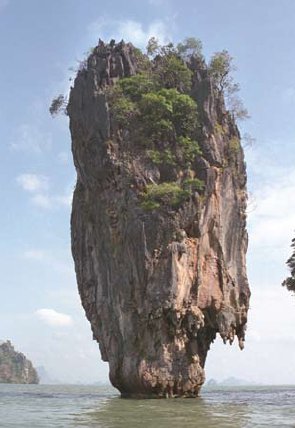
This rather odd-shaped mushroom rock is in Thailand, and housed Scaramanga’s powerful solar device in The Man With The Golden Gun.
From tracking down gunsmith Lazar in Macau, the former Portuguese enclave west of Hong Kong, we visited and filmed on the Floating Macau Palace – a converted vessel moored on the western shore – then took the ferry across the bay to Kowloon (the mainland suburb of Hong Kong), and the Peninsula Hotel, which famously (so Bond was told) runs a fleet of green Rolls-Royce limousines. I thought it seemed more famous for its array of shoes, until I learned Imelda Marcos was in residence.
BOTTOMS UP …
The Bottoms Up Club, was also found in Kowloon amid the neon dazzle of the Tsim Sha Tsui shopping district. Villain Hai Fat’s estate was located at the Dragon Garden on Castle Peak Road, Castle Peak. Once I’d seen him off it was on to Bangkok for a few weeks, and a boat chase through the filthy klongs that criss-cross the city.
‘Under no circumstances should a drop of the water touch your lips,’ we were all warned. The diseases contained therein were deemed enough to give any chemist nightmares.
Unfortunately, after taking a corner – near an undertaker’s – a little too tightly in the boat (a long-tailed sampan) I was driving, I lost my balance and tipped over into the water. I stayed tight-lipped under the water to avoid the rotor blade that was whizzing about overhead, but made the mistake of opening my eyes; and saw what a ‘no frills’ burial meant in that particular establishment.
Other locations included the karate school in Muang Boran, about twenty miles east of town in Changwat Samut Prakan, which was actually an ancient city and the world’s largest outdoor museum, with scaled-down versions of the famous buildings and temples of Bangkok. Most famously, we then moved on to Scaramanga’s island hideout on Khow-Ping-Kan – one of a chain of tiny jungle-covered limestone pillars in Phang Nga Bay, Phuket.
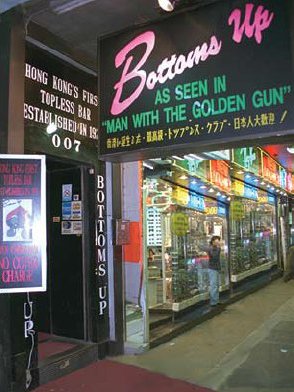
It pays to advertise. The Bottoms Up Club as seen in my second Bond film. Wonder if I’d get a free drink there?
It was a remote and undiscovered paradise at the time we filmed there, without even the most basic of facilities. The art department went ahead and built a small six-bedroomed prefabricated billet for myself, Christopher Lee, Guy Hamilton, Maud Adams and Britt Ekland to lodge in. Each room contained a bed, a large circulating ceiling fan and a short step down into a toilet that was 2 foot 6 inches square, with a dripping tap and bucket to slosh out the hole between the footsteps. I worked out I could sit on the steps, do what came naturally, while washing and shaving at the same time. Cubby went one better and said if I could have given him a broom, he could ‘shove it up [his] rear end and brush out the room at the same time’.
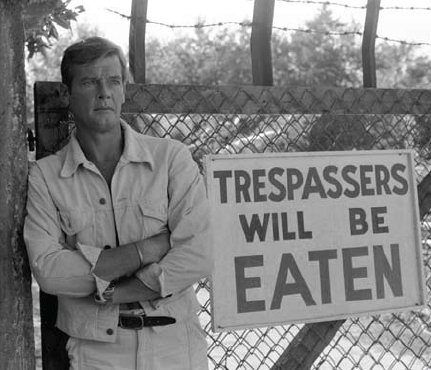
Whilst doing a recce, the crew discovered this terrific crocodile farm entrance and wrote it into the script.
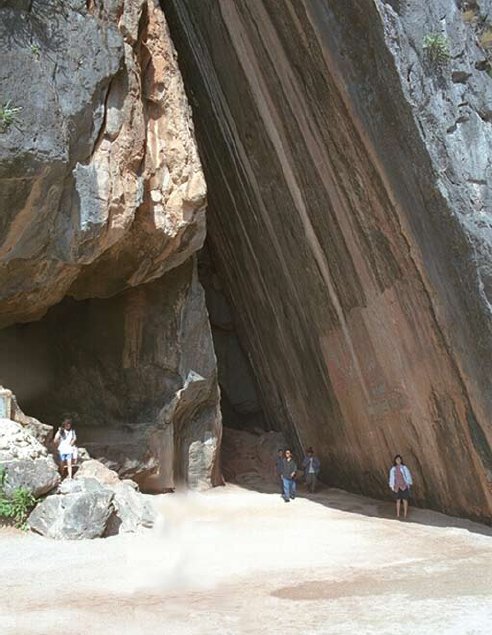
This innocent-looking cave doubled for Scaramanga’s lair. I bravely entered with Christopher Lee only for a mass of bats to fly out (past us). I don’t think they were vampire bats, though.
Today, it’s overrun by tourists (and souvenir shops) who take the fifty-four-mile bus journey north from Phuket Town, and a short boat trip out to see ‘James Bond Island’, as it’s now known.
GOOD AND BAD
The Spy Who Loved Me started shooting in Sardinia, which became one of my favourite locations of all time, in no small way due to our being based at the Cala di Volpe. It was one of the most luxurious hotels ever, and featured in the film as Bond and Anya’s hotel. I was also scheduled time to learn to ride the wet bike (or jet ski, as they are now called) in the beautiful blue sea just outside my room, which was no hardship whatsoever.
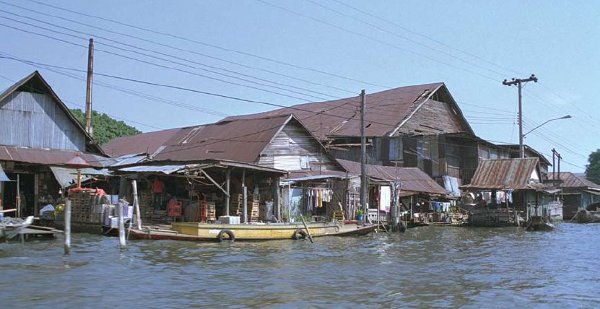
One of the many, rather polluted, waterways we filmed on in The Man With The Golden Gun. We were warned to keep our lips tightly closed if we fell in. I wish I’d kept my eyes closed too, particularly near the undertaker’s.
Then we set off for Cairo, arriving on my birthday, in fact. I walked onto the location set and couldn’t quite understand why there were so many huge tents in the catering area. Catering manager George Crawford walked over, smiling widely, and said it was for my birthday lunch and, what’s more, he’d managed to find lobsters for us all. I looked down at these green creatures he proffered – which were still moving despite having been dead for six weeks! The birthday boy did not have the lobster for lunch, and lived to see another year.
From Cairo it was on to Luxor, and quite probably the worst hotel in the world. The same menu was presented to us every single night of our two-week stay. It was the only large hotel in Luxor at the time, and guests seemingly only ever stayed for one night when they came to visit the temple of Karnak. My nightly meal consisted of what looked and tasted like a camel’s testicle on a bun – it was difficult to figure out which was which.
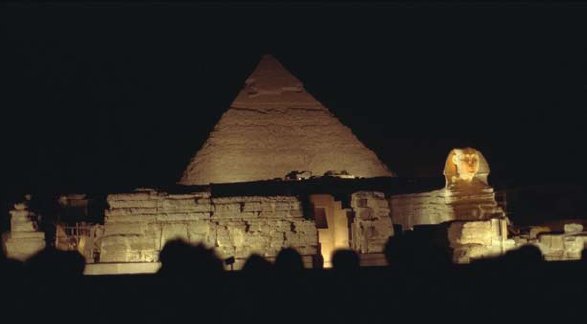
Despite what you may think, the pyramids were not one of Ken Adam’s designs! Though they did make a wonderful backdrop for my first encounter with Jaws in The Spy Who Loved Me.
I was so pleased when director Lewis Gilbert suggested we take an early plane out on our day of departure, meaning we could have a four-hour stopover in Cairo, before flying back to London. Cubby liked the sound of that. ‘We can go to Shepheard’s Hotel for a slap-up lunch,’ he beamed.
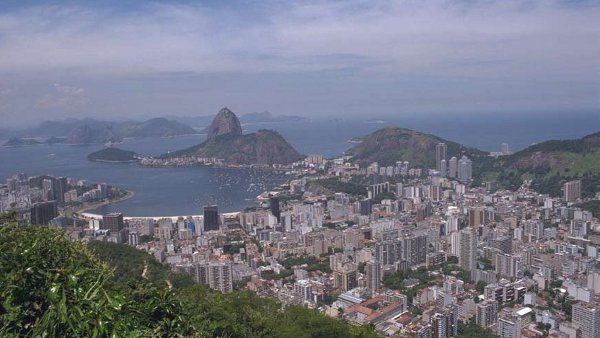
Rio really is a breathtaking panorama.
At Cairo airport the customs officials – not realizing how undernourished we were – said we had to remain airside, as we were ‘in transit’ and could not therefore go into the city. But they told us not to worry, they’d prepared a couple of rooms for us to rest in. I said I’d share with Cubby while Lewis had his own room next door. No sooner had we walked in than Cubby proceeded to take his trousers off.
‘I’ve got the part, Lewis!’ I shouted through the wall.
GIDDY HEIGHTS …
Moonraker decamped from our usual Pinewood base to Paris. Filming with the wonderfully civilized French working hours – long lunches and beautiful architecture – was only slightly frustrated by being split across three separate studios in the city.
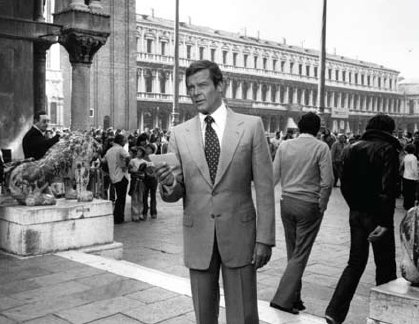
The famous St Mark’s Square in Venice with some old English actor looking lost.
It was then on to Venice and the delightful Hotel Danieli (although I prefer the Gritti Palace, personally) for the action sequences, spread between the city’s 118 islands. The Venetian glass museum, in which Jimmy and Chang fought it out, was actually shot at Boulogne Studios – in a building that had once been a World War II Luftwaffe factory during the occupation. The sequence still holds the record for the largest amount of breakaway sugar glass used in a single scene.
After spending a family Christmas in Paris, the cast and crew travelled to Rio de Janeiro on Concorde. Unfortunately, I suffered an attack of kidney stones and had to spend a few days in a Parisian hospital before flying down to Rio, where I was immediately whisked off the plane to hair and make-up, before re-boarding to film the sequence of 007 arriving.
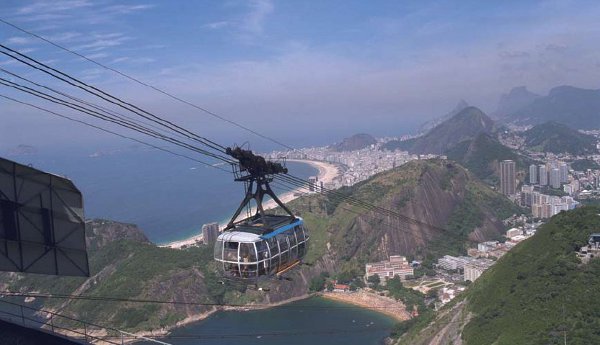
And I recommend viewing it by cable car, if there are no steel-toothed hoodlums around.
It was there one of the most challenging stunts ever took place, atop two cable cars on Table Mountain, two-thousand feet up in the air, with Dickie Graydon and Paul Weston doubling for Jaws and Jim Bond.
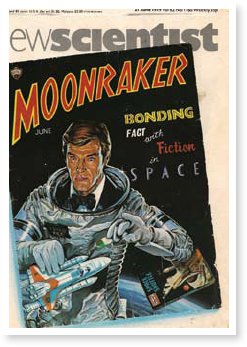
The first and only time I made the cover of New Scientist, here flagging up the fact that our next Bond location was going to be in space. I enjoyed the place, but it did lack atmosphere.
No visit to Rio would be complete without seeing the carnival. Scenes were recreated with some 700 extras to cut into footage previously shot by the second unit in the previous summer.
We then travelled inland to film at Iguassu Falls, the second largest waterfalls in the world – and perhaps the toughest of any location I’ve been on. There was no way of transporting equipment there, apart from carrying it on our backs from the bottom of the valley. The top of the falls was often cloaked by clouds, and Lewis suggested I should follow one of the bevy of Drax’s girls across the top of the falls and inside to the hidden HQ. When I looked at the said girl I was rather taken aback – she was totally cross-eyed, and looked to my left as she spoke to me, with her eyes drifting ever further sideward. I had to follow this girl across the top of a sheer drop! I raised my concerns with Lewis that she couldn’t even see straight. ‘That’s OK, dear,’ he said. ‘We’ll tie a rope to your feet.’
The scene culminated in a speedboat plummeting over the top of the falls, but, due to the weather and spray, several attempts failed, so the scene was eventually shot with miniatures at the studio.
Of course it was one film where Jim also left terra firma and headed into space. The hotels there were awful. If I were you I wouldn’t bother.
AND NOT SO GIDDY …
From the wondrous scenes of Rio and Venice, the opening sequences of For Your Eyes Only took us to Stoke Poges cemetery near Slough and Becton gas works. Very glamorous! The Becton site had previously doubled for Vietnam in Stanley Kubrick’s Full Metal Jacket, but now my brave stunt double Martin Grace held onto the outside of a helicopter, not trying to evade any military action, but rather that of a crazed bald man with a penchant for white cats.
Fortunately, we then moved on to Corfu, Cortina d’Ampezzo – the latter to film snow scenes, but ended up having to truck the white stuff in after it failed to materialize naturally – and Greece, which was slightly more exotic than Becton, though none the less problematic.
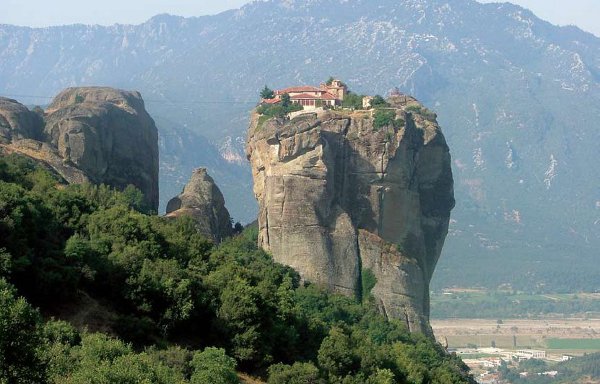
When the monks discovered it was a James Bond film they’d given permission to film at their monastery, at Aghia Triatha, Meteora in Greece, they were rather upset and hung out their dirty habits … along with tarpaulins and anything else they could find to spoil our shots. Thankfully, Cubby managed to smooth things over with a large donation to their charitable fund.
The mountaintop monastery at Meteora, two kilometres north of Kalambaka in central Greece, was to be the scene of the film’s finalé. Like twenty-three other monastries in the area, Aghia Triatha was built in a pretty inaccessible location during the Serbian–Byzantine wars of the fourteenth century, where the only access was by removable wooden ladder.
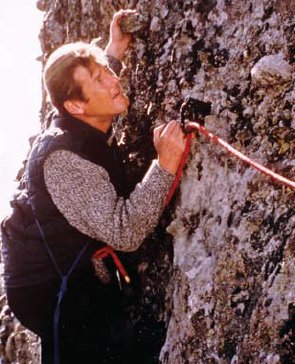
I told our caring director I hated heights. He suggested I take tranquilliser and just get on with climbing the mountain in Meteora to reach the monastery. So I did.
A deal was done in advance with the monks to allow us to film, though I’m not quite sure our man told them it was going to be a Bond film, as once they realized such a womanizing, gambling and ruthless character was due they protested by hanging out their washing and huge tarpaulin sheets all over the roofs. It was not the panoramic scene our cameraman had envisaged.
I tried to reason with them, saying I’d once been a saint, but that didn’t go down too well. Cubby intervened and made a charitable donation, which seemed to placate their worries more readily.
The monastery can be visited today by tourists with a good head for heights, and suitably restrained clothing – but don’t worry, it can be hired when you get there. Those enterprising monks think of everything.
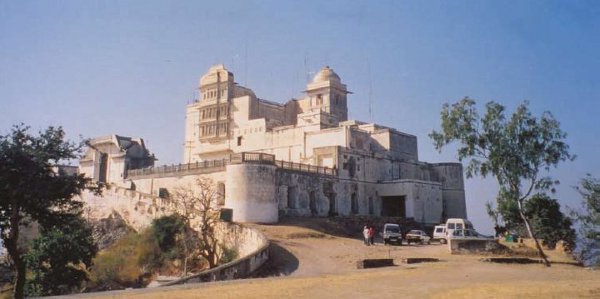
The Monsoon Palace, HQ of the evil Kamal Khan. There seem to be more aerials on the roof than anything else these days, maybe all tuned into one of my old TV series?
Cortina was another interesting location we moved on to, chosen primarily for the abundance of snow. The only thing was, there wasn’t any when we turned up! However, we had a wonderful stay, and filmed at the Miramonti Majestic Hotel. I remember Jim’s room was number 300. It doesn’t actually exist, though the balcony he is seen on does and belongs to room 108.
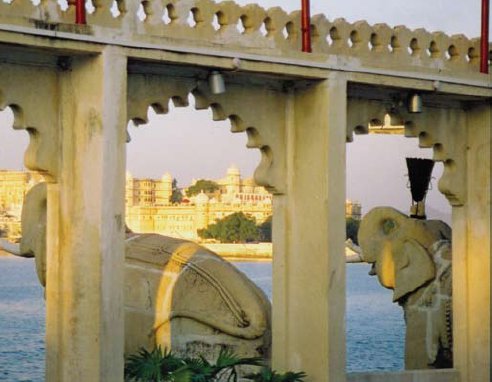
Octopussy made her lair at the Lake Palace Hotel. The crew were warned not to let a drop of river water touch their lips. Many fell in, all survived.
IF YOU KNEW CUBA …
Octopussy was a lovely shoot. We started on 10 August 1982 at Checkpoint Charlie in West Berlin. The Berlin Wall was still in place and the Cold War had yet to defrost. In the scene, Bond and M are in a car heading to the border, and while M gets out Bond continues across to East Berlin. Of course, we couldn’t do it for real and so the car drove a few yards into no man’s land before John Glen called, ‘Cut!’ Happily, the curious East German guards didn’t have time to react, as we turned around and drove back quickly.
After six days in Berlin, it was back to Pinewood Studios and UK locations, including Wansford in Cambridgeshire, for the Nene Valley Railway and the majority of the train sequences where Bond infiltrates and faces off against Orlov. The same location doubled for Russia twelve years later, when director Martin Campbell filmed the train-vs-tank sequence in GoldenEye along stretches of the six-mile private track.
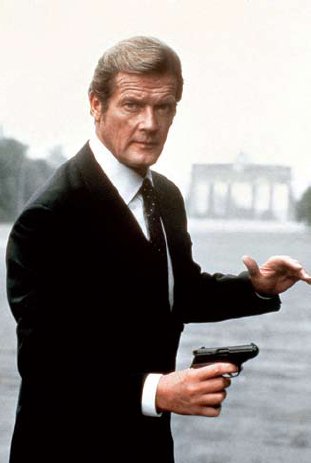
I posed outside the Brandenburg Gate with a Walther PPK in Octopussy. An understated presence, as always.
RAF Upper Heyford, Oxfordshire, doubled for a West German Air Base where a huge circus was staged and, as mentioned earlier, RAF Northolt then doubled for Cuba, with the addition of a few carefully placed palm trees.
We then moved to India, and in particular Udaipur, the city of sunsets. There, the Lake Palace Hotel, which is spread across a four-acre island and constructed from marble on Lake Pichola, became Octopussy’s floating palace. The interiors and courtyards of the palace were shot back at Pinewood, much to the relief of cast and crew, who were struggling in the high temperatures; in fact I needed a new shirt and suit jacket almost every take. As you know, of course, James Bond does not sweat, and the wardrobe and make-up department constantly touched me up in order to keep Jim looking cool and collected – no mean feat when temperatures ranged from 48 to 65 degrees Celsius.
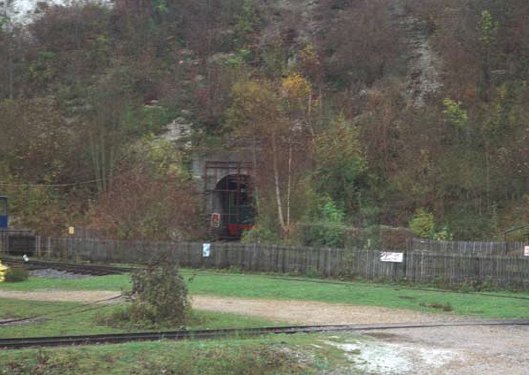
Not quite California – Amberley Working Museum in West Sussex doubled for the mine where Zorin was going to trigger his dastardly plan of dominating Silicon Valley.
At the nearby Shiv Niwas Palace, a team of models were flown from England to partake in the obligatory poolside shoot and when the call went out to recruit some locals for extra work, we were inundated with thousands of people. Many had to be paid off just to leave, as we couldn’t have shot; in fact it became a daily occurrence for hundreds of onlookers to appear on set. The logistics of organizing crowd control during the stunt and chase sequences proved a bit of a challenge, and not always a successful one: the bicycle rider who broke up the tuk-tuk fight was not intended to be in shot at all, he was merely passing through.
The final Indian location was the Monsoon Palace, a striking building on the hillside of Udaipur, which became the lair of evil Kamal Khan.
Oh! And while we were on location, the first English-language film ever to screen at Udaipur’s largest cinema was Moonraker. They had good taste, I thought.
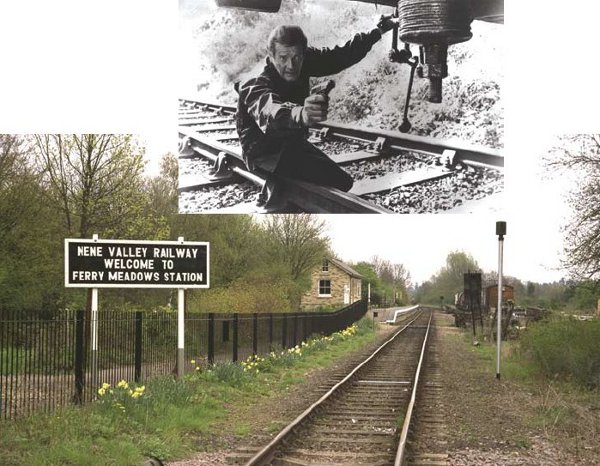
Checking the handbrake is on. The Nene Valley Railway stood in for East Germany in an exciting train sequence in Octopussy. It also doubled for Russia in GoldenEye!
A MAYORAL FAVOURITE
A View To A Kill thankfully avoided the heat of India and Thailand and instead took us to Paris, Chantilly and, of course, San Francisco. At the end of the working day, we had somewhere to go and eat in comfortable surroundings and didn’t have to worry about what we were eating!
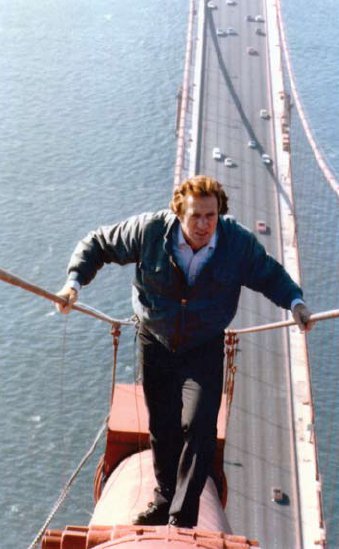
We filmed the climax to A View To A Kill on the Golden Gate Bridge. Here my brave stunt double Martin Grace climbs up to the top, some 227 metres above the water.
The snowy opening in Iceland was filmed by the second unit, and I was cut in with pick-up shots at Pinewood before we all headed to Royal Ascot, and then on to Staines for the scene in which Bond and Stacey enter the Zorin mineshaft, along with the Amberley Chalk Pits Museum in West Sussex, which both doubled for California.
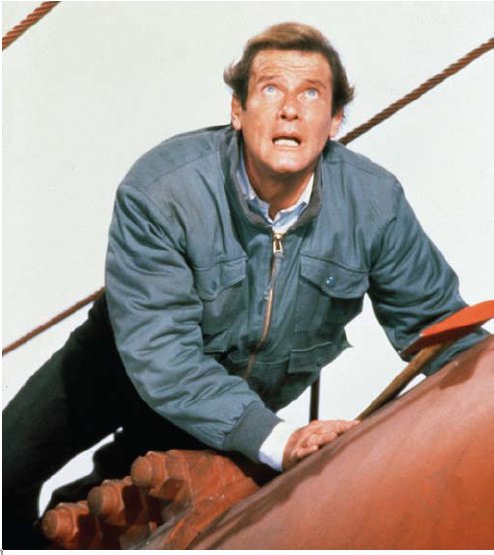
Whereas I filmed my close-ups on a Pinewood set out on the backlot, just a few metres above the ground.
When San Francisco was touted as a filming location, Cubby sought the necessary permissions from the Mayor’s office – the Mayor at that time being Diane Feinstein – explaining they’d like to set City Hall on fire, stage a chase with a fire engine through the streets, and film the climax on top of the Golden Gate Bridge. The response was not particularly positive.
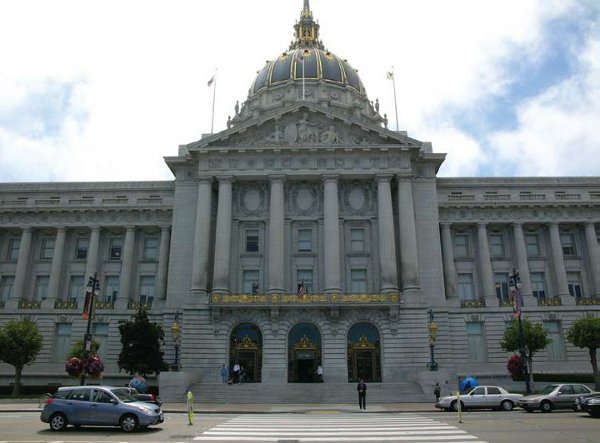
City Hall, San Francisco. Our special-effects team carefully laid smoke pots and started controlled fires on parts of the exterior. I believe we were one of the few film crews, if not the only one, ever allowed to wreak such havoc with the full blessing of the Mayor.
‘Who is playing Bond?’ Mayor Feinstein asked.
‘Roger Moore.’
‘Roger Moore? Ah! I like him,’ she replied. ‘What can I do to help, Mr Broccoli?’
The only caveat to our filming atop the bridge was that there couldn’t be any fighting – there could be a bit of a struggle, but no out-and-out fight. My brave stunt double Martin Grace climbed to the top of the bridge – after earlier holding onto the guy rope of the airship as it crossed the harbour – to perform the final tussle, while part of the bridge was then reconstructed on the Pinewood backlot for me to film my close-ups, looking very brave.
There were even mightier heights to climb, as in Paris it was planned that B.J. Worth would film a parachute jump off the Eiffel Tower, after I had chased Grace Jones up most of it. Curiously, while permission had been granted for the jump, as the landing was going to be on a boat cruising down the Seine, that came under a different authority, and at first they refused permission: we could jump, but couldn’t land. However, eventually all was smoothed over …
PINEWOOD BOUND
Of course, I must also pay homage to the home of 007 and indeed my second home, Pinewood Studios. I shot all of my films – except Moonraker – out of Pinewood, and have a huge affection and appreciation for the studio. For many years my office was right next door to Cubby’s, and I’d like to think we were good neighbours. Now Barbara and Michael occupy Cubby’s office and the tradition continues. The studio has featured extensively in the films – Goldfinger’s factory was the studio ‘covered way’ on the lot; the opening shots in From Russia With Love were filmed in the gardens; in The World Is Not Enough villainous Reynard hid away in the Pinewood pond grotto; the Ice Palace exterior in Die Another Day was all built on the backlot; and, of course, the huge volcano set in You Only Live Twice stood next to the present site of the 007 stage and could be seen from miles away. Pinewood and Bond are linked very closely, and hopefully will be for many years to come.
Of course, since my time Jimmy has ventured to all manner of new interesting places outside the studio walls; in particular, behind the Iron Curtain and Eastern Blocks. Where will he go next we ask? Well, Skyfall was rumoured to be returning to India, but then switched to Turkey instead, where the action sequences could be better accommodated. There were also rumours abound about South Africa and China.
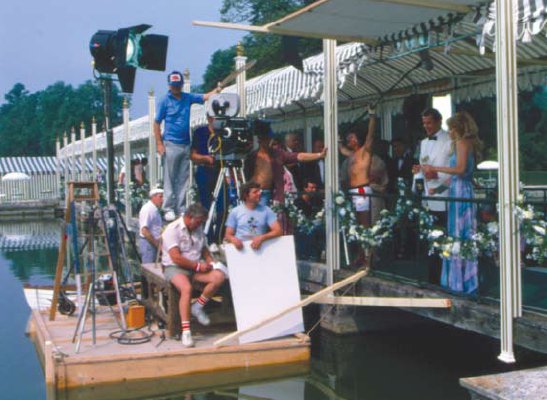
On location in Chantilly – it may just be two of us in shot, but a lot goes on behind the camera!
One thing is for sure: when the phone rings next and a voice says, ‘I’m working for Eon Productions and would like to talk about shooting the next Bond film in your country …’ they’ll be greeted with open arms.